An RV is a home on wheels. Just as most homes have plumbing and sewer systems, RVs come with holding tanks to address those needs in a mobile setting. The fresh water tank, black water tank, and RV gray water tank provide the means to deal with plumbing and sewerage in your home on wheels.
While the fresh and black water tanks’ purposes may seem evident from their names, what exactly is an RV gray water tank? Read on to find out.
- 1) What is an RV Gray Water Tank?
- 2) The Holding Tanks on Your RV
- 3) Average RV Gray Water Tank Capacity
- 4) How Long Does it Take a Gray Tank to Get Full?
- 5) What Happens When Your RV Gray Water Tank is Full?
- 6) How to Dump RV Gray Water
- 7) Can You Dump RV Gray Water on the Ground?
- 8) How to Keep Your RV Gray Water Tank Clean
What is an RV Gray Water Tank?
An RV gray water tank is the holding tank into which your RV’s sink(s) and indoor shower drain. The term gray water refers to all used water in your RV except for toilet water.
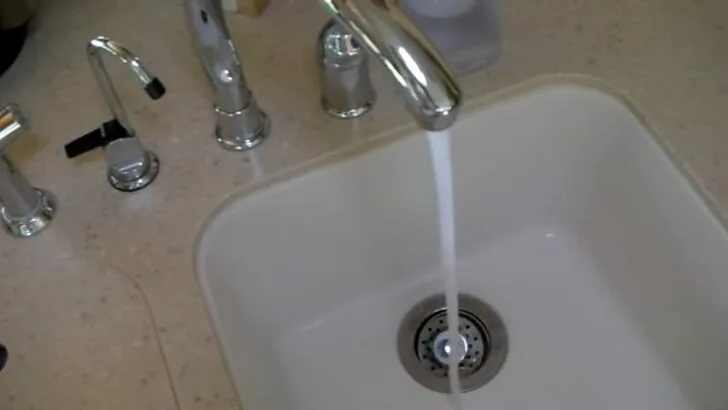
Most RVs have kitchen and bathroom sinks and showers that drain into the RV gray water tank.
So, the galley (kitchen) sink, the bathroom sink, the indoor shower (and bathtub if you have one) all drain into the gray tank. When you wash dishes in your kitchen sink, or brush your teeth in the bathroom sink, the wastewater goes down the drain and into the gray tank.
There are exceptions to this, however. For example, the shower of the Winnebago Rialta (made from 1995-2005) drains into its black tank! And some fifth wheels may have a bathroom sink that drains into the black tank (check your owner’s manual).
Some larger RVs have washing machines and/or dishwashers, which usually drain into their gray tanks. However, many come with notices stating that you should only run them when they’re hooked up to a sewer line at a campground or RV resort with the gray valve open. This is to ensure that you don’t risk overfilling the RV gray water tank.
The Holding Tanks on Your RV
As previously noted, there are likely to be three holding tanks on your RV. Let’s briefly review the purpose of each one.
Gray Water Holding Tank
Your RV gray water tank is where your gray water goes. In many cases, the tank itself is gray, which makes it pretty easy to identify! Any water from your kitchen sink, bathroom sink, and indoor shower will drain into the gray water tank.
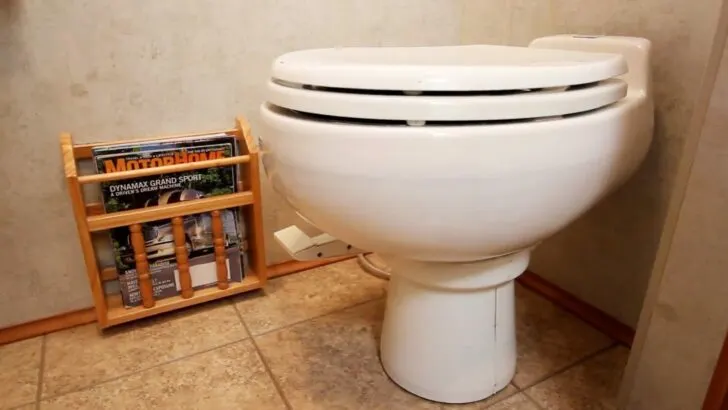
An RV’s toilet drains into its black water tank.
Black Water Holding Tank
Your black water holding tank is where your sewage goes. Anything that drains from your toilet(s) goes into the black water tank. If you look at this receptacle under your RV, it’s very likely black!
Fresh Water Holding Tank
The fresh water holding tank is where your fresh water is stored. It’s often white or translucent, and is used to store water for your use on the road. You’ll fill this tank with fresh water from a potable hose, and it will stay there until you need it for drinking, bathing, washing dishes, etc.
Please note that there’s a difference between a potable (drinkable) water hose and a regular garden hose. If you use water from a garden hose, you might have contaminants in your water since this hose type isn’t rated for potable use.
Average RV Gray Water Tank Capacity
It’s difficult to state an average RV gray water tank capacity because an RV holding tank’s size generally corresponds to the RV’s size. So a Class A motorhome will typically have a larger gray water tank than a Class B campervan, for example.
But to offer a general idea of gray water holding tank sizes, let’s look at the various classes of RVs:
- Class A RVs will generally have a gray water tank that holds between 40 and 65 gallons for starters.
- Fifth-wheels generally offer about the same, but some 5th-wheel travel trailers can hold as much as 95 gallons, or more, in the gray water tank, and some larger models even have two gray tanks. In that case, one might be plumbed to hold water from the bathroom sink and shower, while the other receives water from the kitchen.
- Travel Trailers come in a wide variety of sizes, but typically, small travel trailers may have gray water tanks that hold anywhere from 25 to 45 gallons
- Class C motorhomes often hold between 35 and 50 gallons.
- And finally, Class B RVs typically provide gray water tanks that are more likely to hold only 8 to 30 gallons.
These are all estimates. The best way to know your tank size is to consult the owner’s manual, or the sales brochure from the manufacturer (although be sure to double-check the accuracy of one in particular)!
How Long Does it Take a Gray Tank to Get Full?
How long it takes for a gray tank to fill depends on several factors, including how many people are spending time in your RV.
Many people are conscientious when they shower in an RV, taking “Navy showers” to conserve water and tank space. Others are more liberal. Some RVers have methods for dishwashing that minimize water use and thus save gray tank space at the same time. Therefore, their water use strongly influences your tank’s fill time.
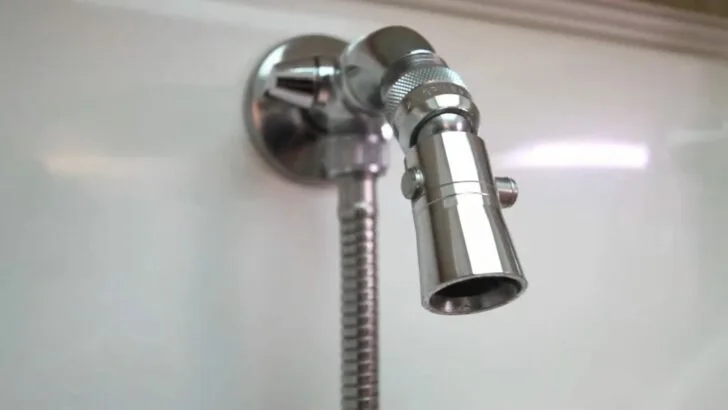
The length of time it takes to fill your RV gray water tank depends on how well you conserve water. Navy showers are one great example of water and gray tank conservation.
If you take a five-minute shower, for example, depending on your shower head, you might use around 10 gallons, which means 10 gallons of gray water is in your tank.
If four people are each taking a five-minute shower every day, that gray tank will fill quickly!
What Happens When Your RV Gray Water Tank is Full?
When your RV gray water tank is approaching full, you’ll want to dump it… either into the sewer line at a full hook-up campsite or into a dedicated sewage facility, also known as a dump station. Many RV parks and campsites have dump stations, but you can often find them at truck stops and rest areas along your trip.
Always follow local guidelines when it comes to gray water dumping. Assume it’s illegal to dump your gray water anywhere other than a designated dumping location… and doing so can bring restrictions that ruin it for the rest of us.
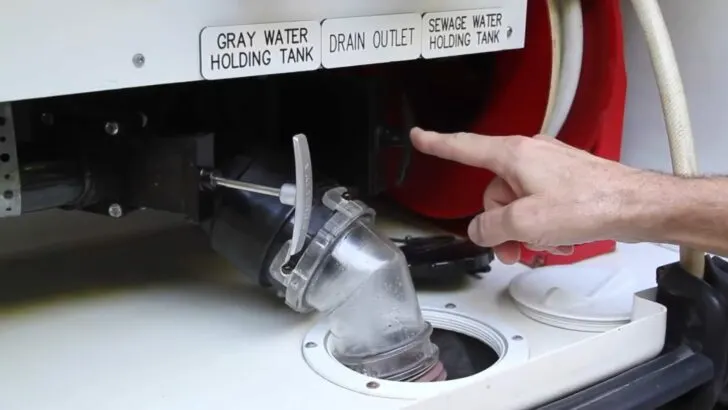
Dumping your RV gray water tank is a matter of connecting your sewer hose to the outlet and pulling a lever to open the gray water valve.
How to Dump RV Gray Water
To dump your RV gray water tank, you’ll connect one end of your RV sewer hose to your RV outlet and the other end to the dump station inlet. You’ll pull the lever to open the gray valve, which is essentially like opening a little “door” or a valve gate.
This action allows the gray tank’s contents to flow into the sewer hose, which will carry it into the dump/sewer station inlet.
Once all the water has drained from the tank, close the gray valve again, disconnect (and rinse out) the sewer hose, and then store it away for next time you need it.
Can You Dump RV Gray Water on the Ground?
It’s never advisable to dump your RV’s gray water on the ground, and in most places, it’s illegal! That’s almost always true in BLM (Bureau of Land Management) locations, wildlife preserves, and other public lands. Assume it’s illegal to dump your gray tank unless posted otherwise (check out our post about the legality of dumping gray water on the ground). Dumping only at approved dump stations and campsites with sewer hook-ups will both preserve our wild lands… and avoid breaking the law.
How to Keep Your RV Gray Water Tank Clean
There are several ways to help keep your RV gray water tank clean. You can start before the water even turns on by minimizing any food particles that are washed down the drain in your galley (kitchen) sink. For instance, use your napkin to wipe off your plate before washing it. Do the same with pots and pans. Any food residue that you can remove from your dishes BEFORE you wash them means there’s that much less to get washed down the drain, helping to keep the gray tank cleaner.
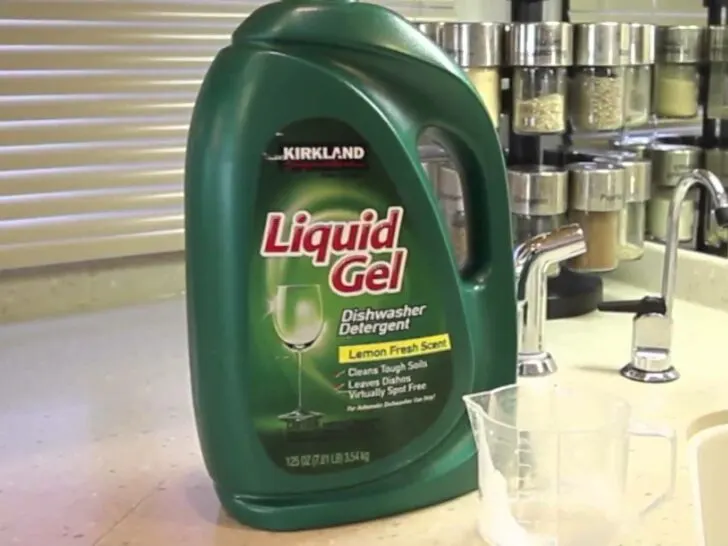
There are a variety of ways to maintain a clean gray water tank including using dishwasher detergent.
If you’re having a problem with odor coming from your gray water tank, there are a couple of simple things to try. First, you can attempt to clean out the inside of the tank itself. You want to use a solution that will break down grease and other fatty buildups that can cling to the tank walls… but not one that will foam up too much.
We recommend using dishwasher detergent. Pour a cup of detergent into the galley sink when your gray tank has about a half tank of water, before a day of driving. Then rinse it into the tank thoroughly. The detergent solution will slosh around as you drive and then sit for a while. The next time you dump your gray water tank, it’ll flush out whatever material you were able to break loose from the tank interior.
Another common cause of gray tank odor inside your RV is the air admittance valves in your plumbing. These one-way valves are installed under sinks and near other plumbing drains. They allow air into the plumbing, helping water to drain smoothly as it goes down. They also prevent the water from siphoning out of the P-trap. If any of your air admittance valves fail, they can allow the P-trap to drain… and tank odors to escape into the RVs living area. ????
Managing RV gray water properly is a key factor in providing a positive RVing experience. A functional tank means you can use household plumbing to enjoy creature comforts like showering while you’re on the road and camping off the grid. While your gray tank is a key part of your RV even when you’re fully hooked up in a campground, it really helps to make the forest, desert, beach, or even a parking lot feel more like home!
Geek Out with Us Every Week
Join our newsletter to learn about all things RV-related. Every week we offer free tips, tricks, product reviews, and more to our online community of RVers. Whether this is your first time on the road or you’re a seasoned expert, we’d love for you to geek out with us!


Drew
Wednesday 14th of April 2021
Hi Guys,
Just one thing about leaving your gray dump valve open. This leaves a path for sewage odors to travel from the campground waste water system back up through your sewer hose and then up your vent stack. Most people have walked through a resort or campground and have experienced the odor from time to time. Sometimes you can just step outside and smell it. In a place that has possibly a hundred or more spaces- you can imagine what it's like if half of those rigs sit with empty gray tanks and open valves.